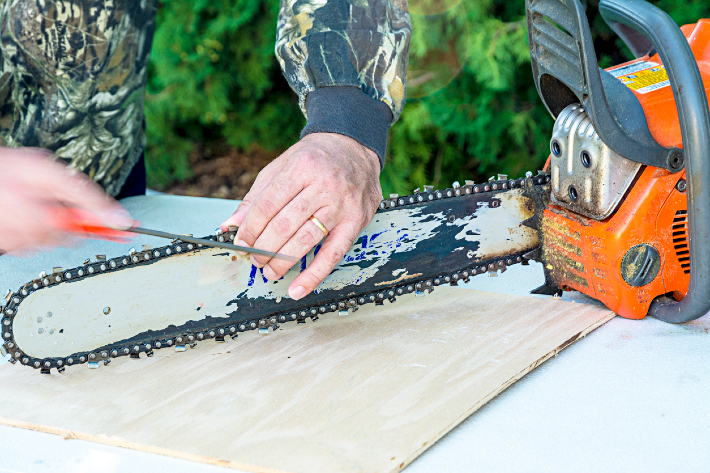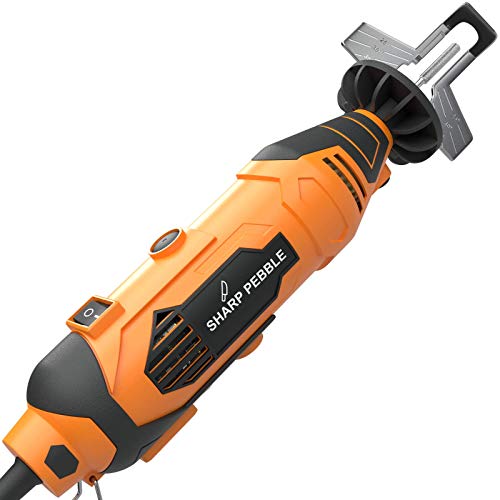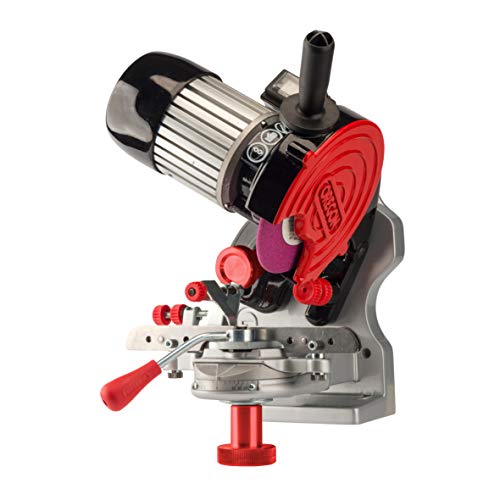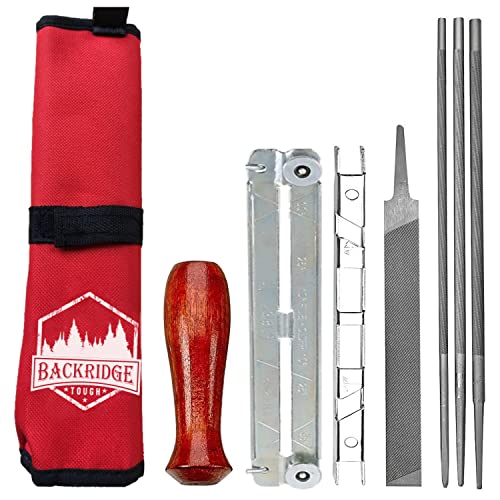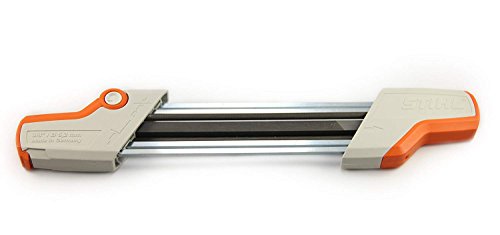- StoreProjects
- Free Plans and Projects
- Furniture Projects
- Jigs And Fixtures Projects
- Shop Projects
- SketchUp Models
- Shop Storage
- Workbenches
- Free Woodworking Downloads From Lee Valley
TechniquesToolsVideos- Premium Streaming Video Site
- Experts Guide to Gluing & Clamping Wood
- Mastering Built-In Furniture
- Simple Live-Edge Slab Table
- CNC – Designed for Woodworkers
- Milling Your Own Lumber
- Advanced Bandsaw Techniques
- I Can Do That! – Simple Woodworking Projects
- Woodwright’s Shop with Roy Underhill
- Tricks of the Trade
BlogOur content is meticulously curated through independent research, testing, reviews, and AI-driven recommendations, all designed to present you with the finest product choices. When you make a purchase through our links, it could result in us earning a commission.The Best Chain Saw Sharpeners to Keep Your Blades Razor-Sharp
Last updated: 19 Jul 2024
The best type of chainsaw sharpener depends on your preferences and experience level. We looked at the user-friendliness, ease of use, and level of sharpness of each sharpener on our list, with the Sharp Pebble Chain Saw Sharpener taking the top spot.
Over time, the teeth of a chainsaw can become dull from cutting through wood and other materials, reducing the efficiency and safety of the saw. Regular sharpening is necessary to maintain the performance and longevity of the chainsaw. A chainsaw sharpener is a tool used to sharpen the cutting teeth of a chainsaw chain. There are multiple types of chainsaw sharpeners: manual, electric, portable, and bar-mounted.
- Best Overall: Sharp Pebble Chain Saw Sharpener Shop Now ➔
- Most Additional Features: Oregon Chain Saw Sharpener Shop Now ➔
- Easiest to Use: BACKRIDGE TOUGH Chain Saw Sharpener Shop Now ➔
- Best Value: Oregon Universal Chain Saw Sharpener Kit Shop Now ➔
- Simplest Design: Stihl Chain Saw Sharpener Shop Now ➔
View all Contents- People Also Ask
- Related Reviews
The Best Chain Saw Sharpeners
Best Overall
On top of the list, we have a Sharp Pebble chain saw sharpener. If you’re serious about keeping your chainsaw in peak condition, you need this life-saving tool. This sharpener comes with everything you need to get the job done, including a 120V chainsaw tool, an angle guide attachment, a wrench, and four file-size diamond sharpening wheels. With its electric automatic sharpening capabilities, this model can handle even the dullest of saw chains quickly and easily.
Because this tool is ergonomically designed for both left- and right-handed users, it’s easy to maintain the correct angle while sharpening. Plus, the adjustable speed settings and quality bearings ensure high efficiency. This product is the best among its competitors due to its lower price, versatile design, and higher sharpening efficiency. You can save time and money by using this powerful sharpener to make the entire process easier!
Pros
- Makes sharp and precise cuts
- User-friendly design
- High stability and accuracy
Cons
- Wrench may be hard to use
Most Additional Features
Moving down, we have the Oregon Professional chain saw sharpener! Keep your chainsaw blades sharp and ready to go with this 120-volt bench grinder. This easy-to-use sharpener can be mounted to a bench or wall. It comes with all the necessary accessories, including two grinding wheels (0.13 inches & 0.9 inches), a dressing brick, profile guide, operator instructions, and a 6.0mm flat profile disc for depth gauge maintenance. If you’re looking for a chain saw sharpener suitable for both semi-professional and household use, this is the one for you! With this top-of-the-line sharpening tool, you’ll always be prepared for whatever cutting job comes your way.
Pros
- Consistent sharpening
- Incredibly sturdy
- Suitable for every chain saw type
Cons
- Can be difficult to adjust angle gauge
Easiest to Use
Next up, we have BACKRIDGE TOUGH chain saw sharpener! This sharpener is easy to use and transport, and it will help you get your work done in half the time. The filing guide ensures that all teeth stay the same size and angle, so you get straighter saw cuts every time. And with multiple file sizes available, this sharpener can be used with all major brands of chain saws. So don’t waste another day fighting with a dull chainsaw. Make the smart choice and pick up this premium sharpening tool!
Pros
- Very precise cuts
- Easy to use
- Easy to transport
Cons
- Very noisy
Best Value
The Oregon Universal chain saw sharpener is a comprehensive sharpening kit. This model comes with everything you need to keep your chainsaw in top condition, including three different sizes of round chainsaw files, a flat-file, and a file guide. Plus, everything is wrapped in a handy rolled pouch with inner pockets and hook & loop closure, so you can keep everything organized and together. And the best part is that the included instruction sheet is inserted into the handle pocket, so you’ll always have it on hand when you need it. So, why put it off? Staying sharp at all times is easier than ever when you have the right equipment!
Pros
- Easy to transport
- Great file type/size variety
- Very quiet
Cons
- Can be difficult to use for beginners
Simplest Design
A chainsaw is only as good as its sharpener. Keep your saw in peak condition with the STIHL chain saw sharpener. This system has two round files, one flat file, a one-of-a-kind filing guide, and a file holder. The STIHL two-in-one filing guide accomplishes more with each stroke, allowing you to spend less time sharpening and more time putting your blade to work. This item is a must-have for every woodcutter since it is durable and simple. So, why delay? Get your hands on this gear as soon as possible!
Pros
- Sharpens chainsaw quickly
- Very durable
- Easy to use
Cons
- Can be difficult to find replacement parts
The Best Chain Saw Sharpener Buying Guide
With several available options, it might be hard to tell which chain saw sharpener is ideal for you. In this buyer’s guide, we’ll help you learn about the different types of chain saw sharpeners and what to look for when choosing one.
What Are the Different Kinds of Chain Saw Sharpeners?
Manual
These are the simplest and most affordable sharpeners. They require manual effort and are ideal for occasional use or for those who prefer a hands-on approach. They usually consist of a round file and a guide to maintain the correct angle.
- Round Files: Specifically sized to match the chain’s cutter tooth.
- File Guides: Help maintain the correct angle and depth while filing.
Electric
These are powered sharpeners that provide quick and consistent results. They come in bench-mounted and handheld versions. Bench-mounted sharpeners are suitable for frequent use and professional settings, while handheld electric sharpeners are portable and convenient for on-the-go sharpening.
- Bench-Mounted Sharpeners: Provide precise control and are suitable for regular maintenance.
- Handheld Electric Sharpeners: Portable and convenient for on-site use.
Bar-Mounted
These are mounted directly onto the chainsaw bar and guide the file to sharpen the teeth evenly. They offer more precision than manual files and are relatively easy to use.
Factors to Consider Before Buying a Chain Saw Sharpener
Type of Sharpener
Manual sharpeners are portable, lightweight, and cost-effective, making them suitable for occasional use or fieldwork. On the other hand, electric sharpeners offer speed and precision, which is ideal for frequent use or when dealing with multiple chains. Bar-mounted sharpeners provide a middle ground, combining electric models’ precision with manual options’ portability. Understanding the advantages and limitations of each type will help you select the one you’d like to have.
Chain Saw & Sharpener Compatibility
Different chainsaws have varying chain sizes, pitches, and gauges. The sharpener you choose should be compatible with the specific dimensions of your chains. Some sharpeners come with adjustable settings or multiple attachments to accommodate various chain sizes, while others are designed for specific types. It’s important to check the specifications of your chainsaw and the sharpener to confirm they match. Compatibility also extends to the power source for electric models.
Ease of Use
A user-friendly sharpener will save time and reduce the risk of errors during the sharpening process. Look for features such as clear instructions, intuitive controls, and ergonomic designs. Some sharpeners have built-in guides or angles to simplify the sharpening process and help achieve consistent results. Electric models should have straightforward settings and easy adjustments. Consider the grip and how comfortable it feels during use for manual sharpeners.
Durability and Build Quality
A well-constructed sharpener made from high-quality materials and can withstand frequent use. Look for sharpeners with sturdy construction, preferably with metal components rather than plastic. Design features like solid bases and secure clamping mechanisms contribute to consistent and precise sharpening. Investing in a durable sharpener might have a higher upfront cost, but it will save money and hassle over time by reducing the need for frequent replacements.
Safety Tips for Sharpening Your Chainsaw
Use Proper Personal Protective Equipment (PPE)
Before sharpening your chainsaw, make sure you have the right personal protective equipment. This includes safety glasses to protect your eyes from metal shavings, cut-resistant gloves to shield your hands, and ear protection to guard against loud noise if you are using an electrically powered sharpener. Sturdy, closed-toe footwear and long sleeves can also provide additional protection against accidental cuts and injuries.
Secure the Chainsaw
Make sure the chainsaw is turned off and completely disconnected from any power source. Secure it firmly in a vice or on a stable workbench to prevent any movement during the sharpening process. A stable chainsaw reduces the risk of accidental slips, which can cause serious injury. Always check that the chainsaw is immobilized before you start sharpening.
Inspect the Chain
Before you start sharpening, inspect the chain for any signs of damage, such as bent or broken teeth, cracks, or excessive wear. If you notice any significant damage, consider replacing the chain entirely rather than sharpening it. A damaged chain can break during use, which poses a significant safety risk.
People Also Ask
How do I choose a chain saw sharpener?
Since there are many kinds of chain saw sharpeners on the market, it's crucial to pick the right one. If you are a professional logger or arborist, you will need a sharpener designed for heavy-duty use. For occasional users, a less expensive and lighter-duty sharpener may suffice.
How do I use my chain saw sharpener?
Most sharpeners come with easy-to-follow instructions. However, if you are not familiar with how to use a sharpener, it is important to ask someone for guidance. There are also many how-to videos online that may tell you how to use your sharpener appropriately.
How do I keep my chain saw sharpener in good shape?
Make sure to clean the sharpener with a cloth after each use. When not in use, you must keep the sharpener in a dry, secure location. It is also necessary to carefully read the sharpener's instructions to ensure you are taking care of it the right way.
What is a chainsaw sharpener?
A chainsaw sharpener is a tool designed to hone the cutting teeth of a chainsaw chain. Sharp chains cut faster and more accurately, reducing strain on both the saw and the user.
Why is regular sharpening important?
Regular sharpening is crucial to maintaining a chainsaw's performance and longevity. Dull chains increase the workload on the motor, leading to potential overheating and damage. Additionally, sharp chains improve safety by reducing the likelihood of kickback and ensuring cleaner, more controlled cuts.
Can a damaged chainsaw chain be sharpened?
Minor damage, such as small nicks and dullness, can often be corrected through sharpening. If the damage is more significant, replacing the chain entirely is safer.
Article Contributors
Read More About Popular Woodworking Reviews Team HereThe Popular Woodworking Review Team’s product reviews and comprehensive guides are here to help you select the best gear and tools to efficiently complete top-quality woodworking projects.
Popular Woodworking is reader-supported: When you buy through links on our site, we may earn an affiliate commission. Artificial Intelligence (large language models) may have been used in the research and creation of the content.
Questions about product testing or a specific articles should be sent to aimperiapt@gmail.com

